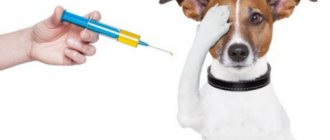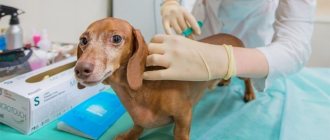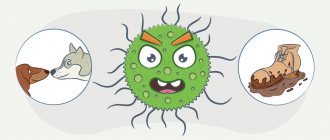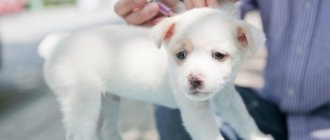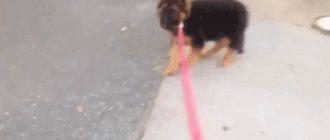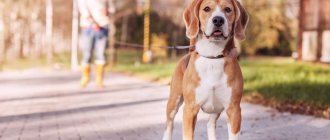- October 19, 2018
- Dogs and hunting with them
- Galina Chebykina
After what vaccination can you walk your puppy? This question interests all people who have a pet and are going to care for it and monitor its health as it should be. Today we offer to learn about what vaccinations an animal must have before it reaches one year of age, and what rules to follow before and after vaccination. You will find out how long you should not walk your dog after vaccination and why.
First vaccination
A respectable breeder will not take a puppy from its mother until the age of 4 weeks, since it is during this period that the baby develops passive immunity through the milk of an adult dog. In this age period, morbidity is very rare.
But is it possible to go for a walk, the puppy’s first vaccination has not been given, but he lives with his mother? The baby has immunity, but it is still weak; the puppy can easily become infected from other animals, from toys, human shoes, and so on. Before the first vaccination, your pet must not have contact with animals that are not vaccinated, and you cannot walk with it either!
At the age of 8 to 12 weeks, the baby becomes extremely susceptible to various types of diseases; it is during this period that the first vaccine is recommended. Next, you need to follow safety rules after vaccination. How long after can a puppy go for a walk? Immunity is developed over the course of 21 days, then re-vaccination is carried out, at the same time vaccination against rabies is carried out. Then the animal again develops immunity over the course of 21 days. Knowing this schedule, you can easily calculate when you can walk your puppy after vaccination.
When to walk your adult dog after vaccination?
Immunization for stronger adult animals is repeated annually, and the injection is given with complex preparations, including pathogens of several infections. It is permissible to add a separate injection to the indicated injection, which forms resistance to rabies. In females, the immunization schedule depends on estrus, mating, and begins a month before the indicated processes.
Walking adult dogs is not prohibited, but by the end of the 11th – 12th month, immunity decreases, so you should walk before and after vaccination for 14 days separately from other dogs, without intense physical activity. It is better to extend the quarantine period to 21 days to avoid contracting rabies. In cold weather, the dog does not need to be washed; just rinse its paws with warm water and treat the coat with dry shampoo.
Read. Vaccine "Kokav"
After quarantine, the dog is gradually returned to active activities, allowed to swim in reservoirs, and restrictions on interactions with any animals are removed.
Vaccinations up to one year
We suggest that you familiarize yourself with the recommended vaccination schedule. Keep it for yourself, because knowing after what vaccination you can walk your puppy, you will be able to find out at what age you will start walking, and protect the animal from contracting dangerous diseases.
- Not always at 3-4 weeks, but the first PUPPY vaccination is given. The vaccine is required only in the most extreme cases: the mother is infected, there is an epidemic in the nursery, the risk of infection of the baby is high. Do not confuse this with the first mandatory vaccination, which will begin the 21-day countdown to the second, and then to the third—against rabies.
- At the age of 8-10 weeks, the dog is given the first vaccination, which develops immunity against distemper, enteritis, hepatitis, parainfluenza, and leptospirosis. As you understand, this is a mandatory vaccination for puppies. When can you go for a walk? It is not recommended to rush, it is better to wait for the third vaccination, and only after that take the baby outside. If there is no choice and the puppy needs to be placed with other animals or taken out into the yard, then do this no earlier than the 14th day after vaccination, since immunity only develops over the course of 2 weeks, and quarantine is necessary.
- 3 weeks after the first vaccination, that is, at the age of 11-13 weeks, the dog is given a second vaccination - a revaccination is carried out, which strengthens the immunity. This vaccination is also mandatory, but only for puppies; subsequent annual vaccinations are administered once. When can a puppy go for a walk after the second vaccination? It is advisable to postpone all walks for another 2-3 weeks and keep the baby in quarantine.
- The rabies vaccine is administered along with the second vaccination. It can be postponed until six months, if until this time the puppy will definitely not have contact with other animals. If you do not vaccinate immediately, then for the safety of both the animal and yours, postpone all walks and accustom your dog to only a diaper at home for now.
- At 6-7 months they give a third vaccination against distemper, enteritis and all other diseases prescribed above. Walking is not recommended for 2 weeks after vaccination.
- The fourth vaccination follows at one year of age. Again, you need to quarantine for 2 weeks.
Features of dog vaccination
Dogs must be vaccinated against the following diseases:
- rabies is an incurable disease transmitted to humans;
- parvovirus enteritis – intestinal pathology, leads to dehydration;
- plague - leads to death, you can become infected with it even if the serum was administered, but the prognosis for recovery in this case will be several times higher;
- parainfluenza - transmitted by airborne droplets, it is recommended to vaccinate dogs during the epidemic;
- leptospirosis is a highly contagious disease transmitted to humans;
- viral hepatitis - affects the liver;
Additionally, you can get vaccinated against fungal infections (lichen) and piroplasmosis. The latter disease is carried by ticks.
2 weeks before vaccination it is necessary to carry out deworming and flea treatment. These parasites weaken the immune system, which can negatively affect the vaccine.
At the time of the procedure, the dog must be completely healthy. If there are any diseases, especially viral ones, the animal is first cured.
The dog becomes slightly weaker after vaccination. There may be a refusal to feed or play; the dog may be lethargic and sleepy. This is a normal reaction. After 2–3 days it goes away completely.
There is a standard vaccination schedule, but the veterinarian can create an individual vaccination schedule depending on the animal’s health condition. Vaccination can be carried out both in the clinic and at home. But only a specialist can do it. The owner needs to ensure that the conditions for storing and transporting the serum are not violated: it cannot be heated or administered after the expiration date.
Inactivated or attenuated vaccines: what is the difference, which one to choose?
Attenuated vaccine. In this case, a small amount of live, weakened viruses is injected into the animal. Once in the blood, viruses begin to multiply, causing the formation of immunity to fight them. The puppy suffers from the disease, but in a weak form, immunity is developed quickly, after a week it is persistent and lasts up to three years!
Inactivated vaccine. This is a larger amount of the injected virus, it does not multiply, immunity is developed more slowly and lasts only a few months.
After what vaccination can you take your puppy for walks before? Theoretically, after attenuated, because immunity is developed within a week. But veterinarians recommend that in both cases it is better to wait the recommended time, and schedule walking only after quarantine after the 2nd vaccine.
What else do you need to know about vaccinations?
Today there are a large number of vaccines on the market that are used to protect pets from diseases. Many believe that imported products, due to their higher cost, have better properties, and the quarantine period after vaccination can be shortened with them. However, this rule remains unchanged; foreign manufacturers also recommend refraining from walking outside for 10–14 days.
The main difference between vaccines is their acceptance in different countries. If you are planning to travel to other countries, it is better to use imported vaccines. You can read more about vaccines here.
There are different types of vaccines. Today there are attenuated and inactivated vaccines. The difference between them is that after the first type of drugs is administered, a small number of viral organisms appear in the dog’s blood, which are able to actively reproduce. But due to their small initial quantity, the animal, although it gets sick, suffers a mild form of the disease, and immunity remains for a long time.
Vaccines of the second type contain a large number of viral microorganisms, but their ability to reproduce is suppressed, which allows the dog’s body to produce antibodies and form immunity to the disease. And although the principles of action of the drugs are different, the recommended quarantine period remains unchanged.
Is quarantine mandatory?
If your dog is not vaccinated or quarantined before and after vaccinations, it can become infected with one of the following diseases:
- plague;
- parainfluenza;
- enteritis;
- rabies;
- leptospirosis;
- infectious hepatitis.
Whether to get the first two and subsequent vaccinations or not is up to you, but in Russia it is mandatory to vaccinate animals against rabies! If you do not comply with the recommended quarantine and walk before vaccinations or immediately after them, then there is a high probability that the animal will get sick. Of course, today veterinary medicine has stepped very far forward, but even if the dog does not die, during the illness he will be severely exhausted, and irreparable harm will be caused to the body.
Possible complications
Like any living beings, dogs tolerate vaccinations differently. The severity of the disease depends on the initial health of the pet, individual characteristics, and conditions of detention. In any case, this is an infection of the puppy with strains of pathogens of the most dangerous diseases.
After vaccination, you may encounter the following changes and manifestations:
- A bump on the withers. After the injection it always appears. The danger is its increase in size and change in color. It is best to share your doubts with a specialist.
- The puppy became lethargic. Within normal limits, the temperature rises to 39 degrees for a maximum of 3 days. Any deviation towards worsening the condition requires medical intervention.
Complications after vaccination
- Diarrhea. This is the most common occurrence. In this way, the body is freed from toxins. You need to monitor the temperature. With diarrhea it increases slightly. Diarrhea leads to severe dehydration. You need to monitor your water consumption. If the puppy does not drink and diarrhea, you need expert advice.
- The baby whines. This is the reaction of a living organism to pain, itching and other unpleasant sensations after an injection. If the temperature does not exceed the permissible level, your pet should be cared for as usual.
- The dog is limping. Lameness is a reaction to pain. You need to monitor your pet's temperature and general well-being.
- The dog has no appetite. She loses her appetite due to toxins. Usually the situation improves within 24 hours.
Need to know ! Refusal to eat for more than a day is dangerous for the animal. Need expert advice.
Vaccination is a difficult ordeal for a small puppy. The weaker the immune system, the more difficult recovery is. But vaccinations are aimed at maintaining the health of the pet. If you follow all the recommendations of a specialist, mandatory vaccinations will guarantee a long, happy life for your dog.
Imported or domestic vaccines?
After which vaccination can you take your puppy for walks first - after imported or domestic? There is absolutely no difference here! When choosing a vaccine from any manufacturer, you must prepare the dog (we’ll tell you how to do this later) and withstand quarantine.
Imported vaccines are more expensive than domestic ones, and many therefore believe that their quality is higher and choose them. But veterinarians insistently recommend that puppies be vaccinated against distemper only with a Russian-made vaccine, since after imported vaccinations there have been cases of infection with this disease, even though the owners vaccinated the dogs following all the rules.
In any case, the veterinarian will advise you on everything himself and tell you about the advantages and disadvantages of any vaccine produced.
What happens if you don’t comply with the quarantine deadlines?
It is especially important to observe quarantine after the first vaccinations of puppies, since, unlike adult pets, their immune system is not fully formed, the clostral immunity received from the mother dog weakens, and the pet’s body is weakened. What happens if you do not comply with the quarantine period?
Important! Failure to comply with the quarantine regime increases the risk of the dog becoming infected with dangerous infections, diseases of viral, bacterial, and parasitic etiology.
Do not forget that vaccination involves the introduction of live, dead strains of bacteria. Therefore, the risk of infection with dangerous viruses and bacteria is very high until the end of the quarantine regime.
Preparing the puppy for vaccination
Only a completely healthy animal should be vaccinated, and the veterinarian will definitely check this. If the puppy is already sick, then vaccination will not help, it will only worsen his condition. This is not a cure, it is the virus itself, only weakened.
To avoid the negative consequences of vaccination, follow these rules:
- A week before vaccination, start measuring the animal’s temperature every day and examining its mucous membranes.
- After vaccination, you cannot walk for at least two weeks! The first walks should be made only in a clean area, without other animals.
- Contact with other animals only 21 days after vaccination.
- If the vaccination is in the morning, then do not feed the animal in the evening; if in the evening, then the last meal is 4 hours before. Vaccination is easier to tolerate on an empty stomach. You can give him something to drink.
Even if all the rules are followed, the animal will feel worse after vaccination. The vaccination itself is stressful, and the virus will begin to awaken the immune system. You shouldn’t worry too much, but you need to give the puppy more attention and care during rehabilitation.
Consequences of failure to comply with dog isolation periods
If you ignore the veterinarian's recommendations regarding the rehabilitation period after vaccination, any irreversible consequences are possible.
How are quarantine periods set?
The deadlines are determined individually in each specific case, taking into account the following factors:
Puppies have a more weakened immune system compared to adults. therefore, a long period of rehabilitation is prescribed for children;- the survival rate of the strain introduced for the first time takes longer, and after each revaccination the quarantine period is shortened;
- It is important to pay attention to the type of vaccine: when using polyvalent strains, the body needs more time to produce antibodies.
In the latter case, the immunization process takes at least 3 weeks. For weakened dogs and puppies, quarantine after polyvaccination should last about 30 days.
Dog at risk
While the body has directed all its efforts to produce antibodies, the animal becomes open to any infection.
If you do not keep your pet at home, the risk of contracting rabies increases many times over, and vaccination will not help save your pet from death.
Other consequences
If quarantine is not observed, dog owners also experience inconvenience.
If the owner violates the conditions of rehabilitation, he will not only not be able to take the pet with him abroad, but will also not be allowed on planes and trains to travel around the country. The dog will not be able to take part in any exhibition.
Deworming
Even those babies who feed only on mother’s milk and do not come into contact with other animals must be treated against parasites before vaccination. If this is not done, then the vaccine will be of no use.
Anti-helminth medications are used 2-3 weeks before the day scheduled for vaccination. Choose the drug carefully; it is better to choose one that is used once. If you choose the one that needs to be applied twice, then you will have to start preparing the puppy from the age of one month in order to have time to carry out the second cleaning before vaccination.
Do I need a rabies vaccination?
Vaccination is the only effective way to protect pets from deadly infections and illnesses of viral and bacterial etiology. And in the first place among vaccinations is the rabies vaccination.
The infection is transmitted through a bite. Rhabdovirus enters the body through open wounds, mucous membranes, and skin lesions. Distributes with the bloodstream, along nerve fibers. It affects the central nervous system and internal organs, causing irreversible changes.
Important! Considering that treatment for this infection has not been developed, the prevention of this disease is controlled in our country and abroad at the state level. If a dog is diagnosed with rabies, the animal is euthanized. And in any case, the infection invariably ends in death.
An infected pet, even without displaying symptoms characteristic of this infection, poses a threat to other animals and humans. If you suspect that your pet may have contracted a dangerous infection, immediately take your dog to a veterinary hospital for an examination.
Rules for walking after vaccination
We figured out when you can walk your puppy after vaccination, now we’ll find out how to do it correctly. After the first vaccine, after 2 weeks you can take your pet outside for a short time, but only in your arms, you cannot let it down to the ground! The first full walk can be scheduled on the 11-14th day after the second vaccination. Observe the following rules:
- Choose a sunny day without wind.
- Find a quiet place where there is no trash, other animals or strangers.
- For the first time, a 20-minute walk is enough.
Before you take your puppy outside, make sure he is in good health. He should not have a fever, lethargy or drowsiness. If the baby is active, eats well and plays, then feel free to take him to get acquainted with the world around him!
First walk
Before taking your puppy for the first time outside, you need to take care of equipment and training. Memorizing basic commands can be done right at home, since they do not require much space to perform them.
Preparation
During quarantine, start purchasing the necessary things and raising your little four-legged animal. To do this you will need:
- Buy a collar (or harness), a leash and warm clothes. Choose high-quality materials that do not cause allergies. In winter, dog boots are useful to protect paws from exposure to reagents.
- Accustom your pet to the purchased ammunition. The leash and collar should not cause fear. Try to reinforce the positive association through food reinforcement or games.
- Teach your baby the commands “Fu”, “Come to me”, “Next” and “Sit”. With their help, you can prevent picking up from the ground and attacking passers-by, as well as adjust your step and direction of movement.
Conduct the lesson in a playful way so that the four-legged dog does not get bored. The best reinforcement at this age is tasty treats, so don't skimp on treats.
When can you take your puppy outside?
It is better to take a walk before eating or at least half an hour after feeding. Otherwise, your pet will be very lethargic and will not be able to concentrate.
During the daytime, go outside immediately after your baby wakes up, and in the evening, try to go out shortly before he goes to bed. Such a walking schedule will help develop the correct regime that excludes activity at night.
Another important point is weather conditions. Do not go outside at temperatures below -10°C or above +30°C. You should also avoid walking if there is strong wind, rain or snowfall outside.
Duration of walking
At first, you need to walk your pet 6 times a day for 10-15 minutes. If you have the opportunity to go out more often, do it. Frequent walks make toilet training easier, so ideally walks should be done every 2-3 hours.
As you get used to the street, try to increase the duration of your walk. Ultimately, it should be 1.5-2 hours - depending on the breed of the animal and your capabilities.
How to increase time and range
At first, the baby will be very afraid, so do not oversaturate him with impressions. Walk away from busy streets along the same route until the puppy adapts to the new sensations. This may take about 3 weeks.
Increase the walking time and distance gradually. A new territory should arouse interest, not fear, so be sure to supplement your walks with outdoor games. Motivation is stimulated by your sincere praise and affection.


